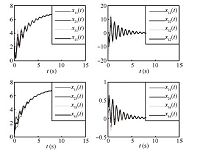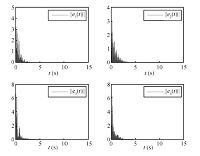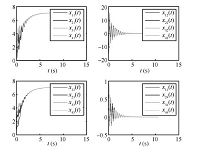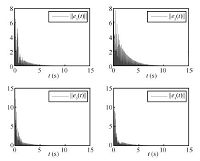Distributed Self-triggered Control for Consensus of Multi-agent Systems
I. INTRODUCTION
Recently,there has been an increasing interest
in event-triggered feedback control systems[1, 2, 3, 4, 5, 6, 7, 8, 9]. In the
event-triggered control,data transmission or control actuation is
executed after the occurrence of an event generated by an
event-triggering mechanism. The event-triggering mechanism often
depends on a well-defined event-triggering condition where the
measurement error plays an essential role. When the magnitude of
the measurement error reaches the prescribed threshold,an event
is triggered. It is noted that the event-triggered technique can
reduce resource usage and provide a higher degree of robustness.
However,in many cases it requires dedicated hardware to monitor
the plant permanently,which is not available in many general
purpose devices. This motives the development of self-triggered
control for digital platforms[10, 11, 12, 13]. In self-triggered
control,the next update time of the controller is computed at the
previous one,without having to keep track of the measurement
error that triggers the execution between two consecutive update
instants. Due to its advantages,self-triggered control of
multi-agent systems (MASs) has been receiving more and more
attention. For example,in [10, 12],some novel self-triggered
control strategies for MASs were proposed,under which MASs
achieved average consensus. It can be observed from those existing
works that self-triggered controller for MASs available nowadays
are based on static state-feedback under a restrictive assumption
that all the agents$'$ states can be measured. It can also be
observed that individual agent dynamics are assumed to be a
single-integrator. Compared with the conventional event-triggered
control on MASs[14, 15],continuous measurement and
communication are not required in this paper,thus some actuation
power and communication resource might be saved. To the best of
our knowledge,there are few works either on self-triggered
control for MASs with general linear dynamics based on state
feedback or on output feedback. This motivates this study.
In this paper,we study the consensus problem of MASs with general
linear dynamics via distributed self-triggered control. Some novel
distributed self-triggered controllers are proposed for MASs$'$
asymptotically consensus. Both state feedback and output feedback
distributed self-triggered consensus problems are investigated
respectively,which help save the resource usage while guarantee a
satisfactory consensus performance. The rest of the paper is
organized as follows. In Section II,the problem under study is
formulated. Sections III and IV provide the main results of this
paper,that is,distributed self-triggered control laws based on
state feedback and output feedback schemes,respectively. An
example is presented in Section V to illustrate the effectiveness of
the proposed control methods. Finally,the conclusions are given in
Section VI.
${\bf Notations 1.}$ For vector $x={\rm col}\left( x_{1},\cdots
,x_{n}\right) \in {\bf R}^{n}$ and matrix $A=[a_{ij}]_{n\times
n}\in {\bf R}^{n\times n}$,$\Vert x\Vert$ and $\Vert A\Vert$ denote
2-norms of $x$ and $A$,respectively. A real matrix $P>0$ $(P<0)$
denotes a positive (negative)-definite matrix $P$. $M^{\rm T}$
denotes the transpose of matrix $M$. The identity matrix of order
$m$ is denoted as $I_{m}$. Moreover,matrices are assumed to have
compatible dimensions if not explicitly stated. $A\otimes B$ denotes
the Kronecker product of matrices $A$ and $B$. $\textbf{1}$ denote
the column vector with all entries equal to one. ${\bf N}$ denotes
the set of positive integers.
II. PROBLEM FORMULATION
The communication topology among agents is represented by an
undirected graph $\mathcal {G}=(\mathcal {V},\mathcal {E},\mathcal
{A})$,where $\mathcal {V}=$ $\{\upsilon_{1}$,
$\cdots,\upsilon_{N}\}$ is the set of nodes with the node indices
belonging to a finite index set $\mathcal {I}=\{1,\cdots,N\}$ and
$\mathcal {E}\subseteq \mathcal {V}\times \mathcal {V}$ is the set
of unordered pairs of nodes,called edges. Two nodes
$\upsilon_{i}$,$\upsilon_{j}$ are adjacent,or neighboring,if
$(\upsilon_{i},\upsilon_{j})$ is an edge of graph $\mathcal {G}$.
A path on $\mathcal {G}$ from node $\upsilon_{i_{1}}$ to node
$\upsilon_{i_{l}}$ is a sequence of edges of the form
$(\upsilon_{i_{k}},\upsilon_{i_{k+1}})$,$k=1,\cdots,l-1$. A
graph is called connected if there exists a path between every
pair of distinct
nodes. The adjacency matrix $\mathcal {A}=$ $[a_{ij}]$
$\in$ ${\bf R}^{N\times N}$ is the matrix with nonnegative
adjacency elements $a_{ij}$ and zero diagonal elements. If edge
$({{\upsilon_i}},{{\upsilon_j}})$ $\in$ $\mathcal {E}$,then node
$\upsilon_{j}$ is called a neighbor of node $\upsilon_{i}$ and
$a_{ij}$ $>$ $0$ $\Leftrightarrow$ $(\upsilon_{i},\upsilon_{j})\in
\mathcal {E}$. The neighbor index set of agent $\upsilon_{i}$ is
denoted by $\mathcal {N}_{i}=\{j\in\mathcal
{I}|(\upsilon_{j},\upsilon_{i})\in\mathcal {E}\}$. The degree
matrix of $\mathcal {G}$ is given by $\Delta={\rm
diag}\{\Delta_1,\Delta_2,\cdots,\Delta_N\}$,where $\Delta_i=$
$\sum\nolimits_{j\in\mathcal {N}_{i}}a_{ij}$. Matrix $\mathcal
{L}=\Delta-\mathcal {A}$ is the Laplacian matrix of graph
$\mathcal {G}$. If $\mathcal {G}$ is connected,its Laplacian
matrix has a single zero eigenvalue and the corresponding
eigenvector is $\textbf{1}$ and the eigenvalues of $\mathcal {L}$
are denoted by $0=$ $\lambda_{1}$ $<$
$\lambda_{2}\leq\cdots\leq\lambda_{N}$.
In this paper,the consensus problem for a group of $N$ identical
agents with general linear dynamics is investigated,which can be
described by
|
\begin{align}\label{1}
\left\{
\begin{array}{lll}
\dot{x}_{i}(t)=Ax_{i}(t)+Bu_{i}(t),\\[1mm]
y_{i}(t)=Cx_i(t),~~ i=1,2,\cdots,N,
\end{array}
\right.
\end{align}
|
(1) |
where $x_{i}(t)\in{\bf R}^{n}$ is the state,$u_{i}(t)\in {\bf
R}^{p}$ is the control input,$y_{i}(t)\in {\bf R}^{q}$ is the
measured output,$A$,$B$ and $C$ are constant matrices with
compatible dimensions. Assume that $(A,B)$ is controllable and
$(A,C)$ is observable. Protocol $u_i(t)$ is said to solve the
consensus problem asymptotically,if the states of agents satisfy
|
\begin{equation}\label{2}
\begin{array}{cll}
\lim\limits_{t\rightarrow
\infty}\|x_{i}(t)-x_{j}(t)\|=0,~~\forall i,j\in\mathcal {I},
~i\neq j.
\end{array}
\end{equation}
|
(2) |
In this paper,both distributed self-triggered state feedback and
output feedback control laws are proposed.
III. DISTRIBUTED SELF-TRIGGERED CONTROL BASED ON
STATE FEEDBACK
In self-triggered control,each control task triggers its next
release based on the value of the last sampled measurement. If all
the states of agents are measurable,the distributed
self-triggered state feedback control law is designed as
|
\begin{equation}\label{3}
\begin{array}{cll}
u_{i}(t)=-\mu F\omega_{i}(t_{k}^{i}),~~t\in[t_{k}^{i},t_{k+1}^{i}),
\end{array}
\end{equation}
|
(3) |
where $\omega_{i}(t_{k}^{i})=\sum\nolimits_{j\in\mathcal
{N}_{i}}a_{ij}(x_{i}(t_{k}^{i})-x_{j}(t_{k}^{i}))$,$\mu$ is a
positive scalar and $F\in{\bf R}^{p\times n}$ is the feedback gain
matrix.
${\bf Remark 1.}$ It is noted that the controller used in most
existing works on event-triggered control of MASs[2, 8, 10]
is triggered at the neighbors$'$ event time,i.e.,$u_i(t)$ $=$
$\sum\nolimits_{j\in\mathcal
{N}_{i}}a_{ij}(x_i(t_k^{i})-x_j(t_{k'}^{j}))$,where
$k'=k'(t)=\arg\max\nolimits_{l\in{\bf N}}\{l|t\geq t_{l}^{j}\}$.
Thus for each $t\in[t_{k}^{i},t_{k+1}^{i})$,$t_{k'(t)}^{j}$ is the
last event time of agent $j$. However,controller (3) is triggered
only at the event time of itself.
The sequence of execution instants for agent $i$ is denoted by
$t_0^{i},t_1^{i},\cdots$. The state measurement error is defined
as
|
\begin{align}\label{4}
e_{i}(t)=\omega_{i}(t_{k}^{i})-\omega_{i}(t),~~t\in[t_{k}^{i},t_{k+1}^{i}),
\end{align}
|
(4) |
where $~\omega_{i}(t)=\sum\nolimits_{j\in\mathcal
{N}_{i}}a_{ij}(x_{i}(t)-x_{j}(t))$. The closed-loop system of (1)
and (3) is
|
\begin{align*}
\dot{x}_{i}(t)=&\ Ax_{i}(t)-\mu BF\omega_{i}(t_{k}^{i})=\\
&\ Ax_{i}(t)-\mu BF(e_{i}(t)+\omega_{i}(t)),
\end{align*}
|
which can be written in a compact form
|
\begin{equation}\label{5}
\begin{array}{cll}
\dot{x}(t)=\bar{A}x(t)-(\mu I_{N}\otimes BF)(e(t)+\omega(t)),
\end{array}
\end{equation}
|
(5) |
where $\bar{A}=I_{N}\otimes A$,$x(t)=[x_{1}^{\rm
T}(t),\cdots,x_{N}^{\rm T}(t)]^{\rm T}$,$e(t)=$ $[e_{1}^{\rm
T}(t)$,$\cdots$,$e_{N}^{\rm T}(t)]^{\rm T}$,and $
\omega(t)=[\omega_{1}^{\rm T}(t),\cdots,\omega_{N}^{\rm T}(t)]^{\rm
T}$. By multiplying both sides of (5) by $\mathcal {L}\otimes
I_{m}$,one has
|
\begin{equation}\label{6}
\begin{array}{cll}
\dot{\omega}(t)=(\bar{A}-\mu\mathcal {L}\otimes
BF)\omega(t)-(\mu\mathcal {L}\otimes BF)e(t),
\end{array}
\end{equation}
|
(6) |
thus
|
\begin{equation}\label{7}
\begin{array}{cll}
\dot{\omega}_{i}(t)=A\omega_{i}(t)-\mu BF\sum\limits_{j\in\mathcal
{N}_{i}}a_{ij}(\omega_{i}(t_{k}^{i})-\omega_{j}(t_{k'}^{j})).
\end{array}
\end{equation}
|
(7) |
Then we have the following result.
${\bf Theorem 1.}$ Assume that the communication graph $\mathcal {G}$
is connected. Given $\delta>0$,consider the controller gain $F$ $=$
$B^{\rm T}P$,where $P>0$ is a solution of the Riccati equation
|
\begin{equation}\label{8}
\begin{array}{cll}
A^{\rm T}P+PA-2PBB^{\rm T}P+\delta I=0,
\end{array}
\end{equation}
|
(8) |
and the triggering instant is chosen such that
|
\begin{align}\label{9}
&t_{k+1}^{i}\leq t_{k}^{i}+\frac{1}{\|A\|}\ln\Bigg(1+\dfrac{d_{i}}{1+d_{i}}\times\notag\\
&\qquad
\dfrac{\|A\|\|\omega_{i}(t_{k}^{i})\|}{\|A\omega_{i}(t_{k}^{i})\|+\|\mu
BF\sum\limits_{j\in\mathcal {N}_{j}}a_{ij}
(\omega_{i}(t_{k}^{i})-\omega_{j}(t_{k'}^{j}))\|}\Bigg),
\end{align}
|
(9) |
where $\mu$ is sufficiently large such that $\mu\lambda_{2}\geq
1$,$d_{i}=\Big(\sigma_{i}\frac{\delta-2\mu\theta
\Delta_{i}\|PBB^{\rm
T}P\|}{\frac{2\mu\Delta_{i}}{\theta}\|PBB^{\rm T}P\|}\Big)^{1/2}$,
with $0<\sigma_{i}<1$ and
$0<\theta<\frac{\delta}{2\mu\max\{\Delta_{i}\}\|PBB^{\rm T}P\|}$,
then $N$ agents in (1) will reach consensus under the control law
(3).
${\bf Proof.}$ Consider a Lyapunov function candidate for the
closed-loop system as
|
\begin{equation}\label{10}
\begin{array}{cll}
V(t)=\omega^{\rm T}(t)\bar{P}\omega(t),
\end{array}
\end{equation}
|
(10) |
where $\bar{P}=I_{N}\otimes P$ and $P>0$. Calculating the time
derivative of $V(t)$ along the solution of (5),one has
|
\begin{align}
\dot{V}(t)=&\ \omega^{\rm T}(t)\big(I_{N}\otimes(PA+A^{\rm T}P)-2\mu\mathcal {L}\otimes PBB^{\rm T}P \big)\times\notag\\
&\ \omega(t)+2\mu\sum\limits_{i=1}^{N}\sum\limits_{j\in\mathcal {N}_{i}}a_{ij}\omega_{i}(t)PBB^{\rm T}P\times\notag\\
&\ (e_j(t)-e_{i}(t)).
\end{align}
|
(11) |
Since $\mathcal {G}$ is connected,zero is a simple eigenvalue of
$\mathcal {L}$ and all the other eigenvalues are positive. Let
$U\in{\bf R}^{N\times N}$ be a unitary matrix such that $U^{\rm
T}\mathcal {L}U=\Lambda={\rm
diag}\{0,\lambda_{2},\cdots,\lambda_{N}\}$. The right and left
eigenvectors of $\mathcal {L}$ corresponding to the zero eigenvalue
are $\textbf{1}$ and $\textbf{1}^{\rm T}$,respectively. One can
choose $U$ $=$ $[\frac{\textbf{1}}{\sqrt{N}}~~X_1]$ and $U^{\rm
T}=\left[
\begin{array}{c}
\frac{\textbf{1}^{\rm T}}{\sqrt{N}} \\
X_2 \\
\end{array}
\right]$,with $X_{1}\in{\bf R}^{N\times(N-1)}$ and $X_{2}\in{\bf R}^{(N-1)\times N}$.
Let $\xi(t)=[\xi_{1}^{\rm T}(t),\cdots,\xi_{N}^{\rm T}(t)]^{\rm T}=(U^{\rm T}\otimes I_n)\omega(t)$.
Notice that $\omega_{1}(t)+\cdots +\omega_{N}(t)=0$. Then $\xi_1(t)$ $=$ $0$,and thus
|
\begin{align}\label{12}
\omega^{\rm T}(t)&\big(I_{N}\otimes(PA+A^{\rm T}P)-2\mu\mathcal {L}\otimes PBB^{\rm T}P \big)\omega(t)=\notag\\
&\ \xi^{\rm T}(t)\big(I_{N}\otimes(PA+A^{\rm T}P)-2\mu\Lambda\otimes PBB^{\rm T}P \big)\xi(t)=\notag\\
&\sum\limits_{i=2}^{N}\xi_{i}^{\rm T}(t)\big(PA+A^{\rm
T}P-2\mu\lambda_{i} PBB^{\rm T}P \big)\xi_{i}(t).
\end{align}
|
(12) |
By choosing sufficiently large $\mu$ such that $\mu\lambda_{2}\geq
1$,one has
|
\begin{align}
&PA+A^{\rm T}P-2\mu\lambda_{i} PBB^{\rm T}P\leq\notag\\
&\qquad PA+A^{\rm T}P-2 PBB^{\rm T}P =-\delta I,
\end{align}
|
(13) |
where the last equation is derived by using (8). It follows from
(12) that
|
\begin{align}
&\omega^{\rm T}(t)\big(I_{N}\otimes(PA+A^{\rm T}P)-2\mu\mathcal {L}\otimes PBB^{\rm T}P \big)\omega(t)\leq\notag\\
&\qquad\ -\delta \|\xi(t)\|^{2}=-\delta \|\omega(t)\|^{2}.
\end{align}
|
(14) |
From (12) to (14) and noticing $a_{ij}=a_{ji}$,one has
|
\begin{align}
\dot{V}(t)\leq& -\delta\sum\limits_{i=1}^{N}\|\omega_{i}(t)\|^{2}\;+\notag\\
&\ 2\mu\sum\limits_{i=1}^{N}\sum\limits_{j\in\mathcal {N}_{i}}a_{ij}\omega_{i}(t)PBB^{\rm T}P(e_j(t)-e_{i}(t))\leq\notag\\
& -\delta\sum\limits_{i=1}^{N}\|\omega_{i}(t)\|^{2}+\mu\|PBB^{\rm T}P\|\sum\limits_{i=1}^{N}\Delta_{i}(\theta\|\omega_{i}(t)\|^{2}\;+\notag\\
&\ \dfrac{1}{\theta}\|e_{i}(t)\|^{2})+\mu\|PBB^{\rm T}P\|\sum\limits_{i=1}^{N}\Delta_{i}\theta\|\omega_{i}(t)\|^{2}\;+\notag\\
&\ \mu\|PBB^{\rm T}P\|\sum\limits_{i=1}^{N}\sum\limits_{j\in\mathcal {N}_{i}}a_{ij}\dfrac{1}{\theta}\|e_{j}(t)\|^{2}=\notag\\
&\ \sum\limits_{i=1}^{N}\Big\{\big(-\delta +2\mu\|PBB^{\rm T}P\|\Delta_{i}\theta \big)\|\omega_{i}(t)\|^{2}\;+\notag\\
&\ 2\mu\|PBB^{\rm
T}P\|\dfrac{\Delta_{i}}{\theta}\|e_{i}(t)\|^{2}\Big\},
\end{align}
|
(15) |
where $\theta$ is a positive scalar defined in Theorem 1. For each
$i$,define the triggering condition as
|
\begin{equation}\label{16}
\begin{array}{cll}
\|e_{i}(t)\|\leq\dfrac{d_{i}}{1+d_{i}}\|\omega_{i}(t_{k}^{i})\|,
\end{array}
\end{equation}
|
(16) |
where $d_i$ is defined in Theorem 1. It follows from (4) and (16)
that $\|e_{i}(t)\|\leq d_{i}\|\omega_{i}(t)\|$. Thus
|
\begin{eqnarray*}
\begin{array}{cll}
\dot{V}(t)\leq\sum\limits_{i=1}^{N}(\sigma_{i}-1)(\delta-2\mu\theta\Delta_{i}\|PBB^{\rm
T}P\|)\|\omega_{i}(t)\|^{2},
\end{array}
\end{eqnarray*}
|
then $\dot{V}(t)<0$,for any $0<\sigma_{i}<1$ and
$0<\theta<\frac{\delta}{2\mu\max\nolimits_{i}\{\Delta_{i}\}\|PBB^{\rm
T}P\|}$. It follows from (4) and (7) that
|
\begin{align}\label{17}
\|\dot{e}_{i}(t)\|=&\ \|\dot{\omega}_{i}(t)\|\leq\notag\\
&\ \|A\|\|e_{i}(t)\|+\|A\omega_{i}(t_{k}^{i})\|+\notag\\
&\ \|\mu BF\sum\limits_{j\in\mathcal
{N}_{i}}a_{ij}(\omega_{i}(t_{k}^{i})-\omega_{j}(t_{k'}^{j}))\|.
\end{align}
|
(17) |
So the evolution of $\|e_{i}(t)\|$ for
$t\in[t_{k}^{i},t_{k+1}^{i})$ is bounded by the solution of
|
\begin{align}\label{18}
\|\dot{p}_{i}(t)\|=&\ \|A\|\|p_{i}(t)\|+\|A\omega_{i}(t_{k}^{i})\|+\notag\\
&\ \|\mu BF\sum\limits_{j\in\mathcal
{N}_{i}}a_{ij}(\omega_{i}(t_{k}^{i})-\omega_{j}(t_{k'}^{j}))\|
\end{align}
|
(18) |
with $p_{i}(t_{k}^{i})=0$. Thus the corresponding solution of (18)
is given by
|
\begin{align}\label{19}
&\|p_{i}(t)\|=\notag\\
&\qquad\dfrac{\|A\omega_{i}(t_{k}^{i})\|+\|\mu BF\sum\limits_{j\in\mathcal {N}_{i}}a_{ij}(\omega_{i}(t_{k}^{i})-\omega_{j}(t_{k'}^{j}))\|}{\|A\|}\times\notag\\
&\qquad({\rm e}^{\|A\|(t-t_{k}^{i})}-1).
\end{align}
|
(19) |
From (16) and (19),one has that
an upper bound of the time for $\|e_{i}(t)\|$ to evolve from $0$ to $\frac{d_{i}}{1+d_{i}}\|\omega_{i}(t_{k}^{i})\|$ satisfies
|
\begin{align}\label{20}
&\dfrac{\|A\omega_{i}(t_{k}^{i})\|+\|\mu BF\sum\limits_{j\in\mathcal {N}_{i}}a_{ij}(\omega_{i}(t_{k}^{i})-\omega_{j}(t_{k'}^{j}))\|}{\|A\|}\times\notag\\
&\qquad
(e^{\|A\|(t-t_{k}^{i})}-1)=\dfrac{d_{i}}{1+d_{i}}\|\omega_{i}(t_{k}^{i})\|.
\end{align}
|
(20) |
Thus the triggering time can be chosen as
|
\begin{align*}
&t_{k+1}^{i}\leq t_{k}^{i}+\dfrac{1}{\|A\|}\ln\Big(1+\\
&\qquad\dfrac{d_{i}}{1+d_{i}}\dfrac{\|A\|\|\omega_{i}(t_{k}^{i})\|}{\|A\omega_{i}(t_{k}^{i})\|+\|\mu
BF\sum\limits_{j\in\mathcal
{N}_{j}}a_{ij}(\omega_{i}(t_{k}^{i})-\omega_{j}(t_{k'}^{j}))\|}\Big).
\end{align*}
|
IV. DISTRIBUTED SELF-TRIGGERED OUTPUT FEEDBACK
CONTROL
If some states of the system cannot be measured,control
strategies based on state feedback cannot be used. In this case,
control schemes based on output feedback should be used. A state
observer can be designed as
|
\begin{equation}\label{21}
\left\{
\begin{array}{lll}
\dot{\hat{x}}_{i}(t)=A\hat{x}_{i}(t)+Bu_{i}(t)+L(y_{i}(t)-\hat{y}_{i}(t)),\\
\hat{y}_{i}(t)=C\hat{x}_i(t),~~ i=1,2,\cdots,N,
\end{array}
\right.
\end{equation}
|
(21) |
where $\hat{x}_{i}(t)\in{\bf R}^{n}$ is the observer state,
$\hat{y}_{i}(t)\in {\bf R}^{q}$ is the observer measured output,
$L\in {\bf R}^{n\times q}$ is a constant matrix to be designed.
Define
|
\begin{align}\label{22}
&\tilde{x}_{i}(t)=x_{i}(t)-\hat{x}_{i}(t),\notag\\%~\hat{\omega}_{i}(t)=\sum\limits_{j\in\mathcal{N}_{i}}a_{ij}(\hat{x}_{i}(t)-\hat{x}_{j}(t)),\notag\\
&\tilde{\omega}_{i}(t)= \sum\limits_{j\in\mathcal
{N}_{i}}a_{ij}(\tilde{x}_{i}(t)-\tilde{x}_{j}(t)).
\end{align}
|
(22) |
The distributed self-triggered observer-based output control law
is designed as
|
\begin{align}\label{23}
u_{i}(t)=-\mu F\hat{\omega}_{i}(t_{k}^{i}),
\end{align}
|
(23) |
where $\hat{\omega}_{i}(t_{k}^{i})=\sum\nolimits_{j\in\mathcal
{N}_{i}}a_{ij}(\hat{x}_{i}(t_{k}^{i})-\hat{x}_{j}(t_{k}^{i}))$.
The state measurement error is defined as
|
\begin{align}\label{24}
e_{i}(t)=\hat{\omega}_{i}(t_{k}^{i})-\hat{\omega}_{i}(t).
\end{align}
|
(24) |
By multiplying both sides of the closed-loop system of (1) and
(23) by $\mathcal {L}\otimes I_{m}$, one has
|
\begin{equation}\label{25}
\left\{
\begin{array}{lll}
\dot{\omega}(t)=\bar{A}\omega(t)-(\mu \mathcal {L}\otimes BF)\hat{\omega}(t)-(\mu \mathcal {L}\otimes BF)e(t),\\
\dot{\hat{\omega}}(t)=(\bar{A}-\mu \mathcal {L}\otimes BF)\hat{\omega}(t)-(\mu \mathcal {L}\otimes BF)e(t)+\\
\qquad\quad (I_{N}\otimes LC)\tilde{\omega}(t),\\
\dot{\tilde{\omega}}(t)=(I_{N}\otimes(A- LC))\tilde{\omega}(t),
\end{array}
\right.
\end{equation}
|
(25) |
where $\tilde{\omega}(t)=[\tilde{\omega}_{1}^{\rm
T}(t),\cdots,\tilde{\omega}_{N}^{\rm T}(t)]^{\rm T}$ and
$\hat{\omega}(t)=$ $[\hat{\omega}_{1}^{\rm T}(t)$,$\cdots$,
$\hat{\omega}_{N}^{\rm T}(t)]^{\rm T}$. It can be observed from the
third equation in (25) that $\tilde{\omega}(t)$ will approach zero
asymptotically if $L$ is designed to make $A-LC$ Hurwitz. Thus the
stability of the second equation in (25) is equivalent to the
stability of the following system
|
\begin{equation}\label{26}
\begin{array}{cll}
\dot{\hat{\omega}}(t)=(\bar{A}-\mu\mathcal {L}\otimes BF)\hat{\omega}(t)-(\mu\mathcal {L}\otimes BF)e(t).
\end{array}
\end{equation}
|
(26) |
Then we get the following result.
${\bf Theorem 2.}$ Assume that the communication graph $\mathcal
{G}$ is connected. Let $L$ be any gain matrix such that $A-LC$ is
Hurwitz. If the triggering time is chosen such that
|
\begin{equation}\label{27}
\begin{array}{cll}
t_{k+1}^{i}\leq t_{k}^{i}+\tau,
\end{array}
\end{equation}
|
(27) |
where $\tau$ satisfies the equation
|
\begin{equation}\label{28}
\begin{array}{cll}
b\tau+\dfrac{c}{a}=\delta {\rm e}^{-a\tau},
\end{array}
\end{equation}
|
(28) |
with $a=\|A\|$,$ b=\frac{\|LC\|}{\|A\|}\|\mu
BF\sum\nolimits_{j\in\mathcal
{N}_{i}}(\hat{\omega}_{i}(t_{k}^{i})-\hat{\omega}_{j}(t_{k'}^{j}))\|$,
$c=(\|A\|+\|LC\|(1+\frac{d_{i}}{1+d_{i}}))\|\hat{\omega}_{i}(t_{k}^{i})\|$
$+$ $(1$ - $\frac{\|LC\|}{\|A\|})\|\mu
BF\sum\nolimits_{j\in\mathcal
{N}_{i}}(\hat{\omega}_{i}(t_{k}^{i})-\hat{\omega}_{j}(t_{k'}^{j}))\|$,
$\delta=\frac{c}{a}+\frac{d_{i}}{1+d_{i}}\|\hat{\omega}_{i}(t_{k}^{i})\|$,
$\mu$ is sufficiently large such that $\mu\lambda_{2}\geq 1$,
$F$ $=$ $B^{\rm T}P$,with $P>0$ being a solution of the Riccati equation (8),and $d_i$ is defined in
Theorem 1,then $N$ agents in (1) will reach consensus under the control law (23).
${\bf Proof.}$ Consider a Lyapunov function candidate for the
closed-loop system as
|
\begin{eqnarray*}
\begin{array}{cll}
V(t)=\hat{\omega}^{\rm T}(t)\bar{P}\hat{\omega}(t),
\end{array}
\end{eqnarray*}
|
where $\bar{P}$ is defined in (10). Calculating the time derivative of $V(t)$ along the solution of (26),one has
|
\begin{align}\label{29}
&\dot{V}(t)=\notag\\
&\qquad \hat{\omega}^{\rm T}(t)\big(I_{N}\otimes(PA+A^{\rm T}P)-2\mu\mathcal {L}\otimes PBB^{\rm T}P \big)\hat{\omega}(t)+\notag\\
&\qquad 2\mu\sum\limits_{i=1}^{N}\sum\limits_{j\in\mathcal
{N}_{i}}a_{ij}\hat{\omega}_{i}(t)PBB^{\rm T}P(e_j(t)-e_{i}(t)).
\end{align}
|
(29) |
Similar to the analysis from (12) to (15),one has
|
\begin{align}\label{30}
\dot{V}(t)\leq&\ \sum\limits_{i=1}^{N}\Big\{\big(-\delta +2\mu\|PBB^{\rm T}P\|\Delta_{i}\theta \big)\|\hat{\omega}_{i}(t)\|^{2}+\notag\\
&\ 2\mu\|PBB^{\rm
T}P\|\frac{\Delta_{i}}{\theta}\|e_{i}(t)\|^{2}\Big\}.
\end{align}
|
(30) |
Thus for agent $i$ the triggering condition can be designed as
|
\begin{equation}\label{31}
\begin{array}{cll}
\|e_{i}(t)\|\leq\dfrac{d_{i}}{1+d_{i}}\|\hat{\omega}_{i}(t_{k}^{i})\|,
\end{array}
\end{equation}
|
(31) |
where $d_i$ is defined in Theorem 1. It follows from (24) and (30)
that
|
\begin{equation}\label{32}
\begin{array}{cll}
\|e_{i}(t)\|\leq d_{i}\|\hat{\omega}_{i}(t)\|.
\end{array}
\end{equation}
|
(32) |
Thus
$$
\dot{V}(t)\leq\sum\limits_{i=1}^{N}(\sigma_{i}-1)(\delta-2\mu\theta\Delta_{i}\|PBB^{\rm
T}P\|)\|\hat{\omega}_{i}(t)\|^{2},
$$
then $\dot{V}(t)<0$,for any $0<\sigma_{i}<1$ and
$0<\theta<\frac{\delta}{2\mu\max\nolimits_{i}\{\Delta_{i}\}\|PBB^{\rm
T}P\|}$.
It follows from (24) and (30) that
$$
\|\hat{\omega_{i}}(t_{k}^{i})-\hat{\omega_{i}}(t)\|\leq\dfrac{d_{i}}{1+d_{i}}\|\hat{\omega_{i}}(t_{k}^{i})\|,
$$
which implies
$$
\|\hat{\omega_{i}}(t)\|<\left(1+\dfrac{d_{i}}{1+d_{i}}\right)\|\hat{\omega_{i}}(t_{k}^{i})\|.
$$
One further has
|
\begin{equation}\label{33}
\begin{array}{cll}
\|\tilde{\omega_{i}}(t)\|-\|\omega_{i}(t)\|\leq\left(1+\dfrac{d_{i}}{1+d_{i}}\right)\|\hat{\omega_{i}}(t_{k}^{i})\|,
\end{array}
\end{equation}
|
(33) |
thus
|
\begin{equation}\label{34}
\begin{array}{cll}
\|\tilde{\omega_{i}}(t)\|\leq
\|\omega_{i}(t)\|+\left(1+\dfrac{d_{i}}{1+d_{i}}\right)\|\hat{\omega_{i}}(t_{k}^{i})\|.
\end{array}
\end{equation}
|
(34) |
From (24) and the first equation in (25),one has
|
\begin{equation}\label{35}
\begin{array}{cll}
\dot{\omega}_{i}(t)=A\omega_{i}(t)-\mu BF\sum\limits_{j\in\mathcal {N}_{i}}(\hat{\omega}_{i}(t_{k}^{i})-\hat{\omega}_{j}(t_{k'}^{j})),
\end{array}
\end{equation}
|
(35) |
then
|
\begin{align}\label{36}
\|\omega_{i}(t)\|\leq&\ \dfrac{1}{\|A\|}\|\mu BF\sum\limits_{j\in\mathcal {N}_{i}}a_{ij}(\hat{\omega}_{i}(t_{k}^{i})-\hat{\omega}_{j}(t_{k}^{j}))\|\times\notag\\
&\ \left({\rm e}^{\|A\|(t-t_{k}^{i})}-1\right).
\end{align}
|
(36) |
From (24) and the second equation in (25),one has
|
\begin{align}\label{37}
\|\dot{e}_{i}(t)\|=&\ \|\dot{\hat{\omega_{i}}}(t)\|=\notag\\
&\ \|A\|\|e_{i}(t)\|+\|A\|\|\hat{\omega}_{i}(t_{k}^{i})\|+\notag\\
&\ \|\mu BF\sum\limits_{j\in\mathcal {N}_{i}}a_{ij}(\hat{\omega}_{i}(t_{k}^{i})-\hat{\omega}_{j}(t_{k'}^{j}))\|\;+\notag\\
&\ \|LC\|\|\tilde{\omega_{i}}(t)\|.
\end{align}
|
(37) |
Substituting (34) and (36) into (37),one has
|
\begin{equation}\label{38}
\begin{array}{cll}
\|\dot{e}_{i}(t)\|\leq a\|e_{i}(t)\|+b{\rm
e}^{a(t-t_{k}^{i})}+c,~~t\in[t_{k}^{i},t_{k+1}^{i}),
\end{array}
\end{equation}
|
(38) |
where $a,b$ and $c$ are defined in Theorem 2.
So the evolution of $\|e_{i}(t)\|$ for $t\in[t_{k}^{i},t_{k+1}^{i})$ is bounded by the solution of
|
\begin{equation}\label{39}
\begin{array}{cll}
\|\dot{p}_{i}(t)\|=a\|p_{i}(t)\|+b{\rm e}^{a(t-t_{k}^{i})}+c.
\end{array}
\end{equation}
|
(39) |
With $p(t_{k}^{i})=0$,the corresponding solution of (39) is
given by
|
\begin{equation}\label{40}
\begin{array}{cll}
\|p_{i}(t)\|={\rm
e}^{a(t-t_{k}^{i})}\left(\dfrac{c}{a}+b(t-t_{k}^{i})\right)-\dfrac{c}{a}.
\end{array}
\end{equation}
|
(40) |
From (31) and (40),one has that the upper bound of the time for
$\|e_{i}(t)\|$ to evolve from $0$ to
$\frac{d_{i}}{1+d_{i}}\|\hat{\omega}_{i}(t_{k}^{i})\|$ satisfies
|
\begin{equation}\label{41}
\begin{array}{cll}
{\rm
e}^{a(t-t_{k}^{i})}\left(\dfrac{c}{a}+b(t-t_{k}^{i})\right)-\dfrac{c}{a}=\dfrac{d_{i}}{1+d_{i}}\|\hat{\omega_{i}}(t_{k}^{i})\|,
\end{array}
\end{equation}
|
(41) |
which can be rewritten as
|
\begin{equation}\label{42}
\begin{array}{cll}
\dfrac{c}{a}+b\tau=\delta {\rm e}^{-a\tau},
\end{array}
\end{equation}
|
(42) |
where $\tau=t-t_{k}^{i}$. Since $\delta>\frac{c}{a}$,$\delta
{\rm e}^{-a\tau}$ approaches zero and $b\tau$ approaches positive
infinity as $\tau$ goes to infinity. Then there exists a positive
scalar $\tau$ that solves the equation. Thus the triggering time
can be chosen as $t_{k+1}^{i}\leq t_{k}^{i}+\tau$. The proof is
thus completed.
V. A SIMULATION EXAMPLE
In this section,an example is provided to validate the effectiveness of the proposed control approaches.
Consider a network described as follows
\begin{align*}
\left\{
\begin{array}{cll}
\dot{x}_{i}(t)=&\!\!\!\!\!\left[
\begin{array}{cccc}
0 & 1 & 0 & 0 \\
-48.6 & -1.25 & 48.6 & 0 \\
0 & 0 & 0 & 10 \\
1.95 & 0 & -1.95 & 0 \\
\end{array}
\right]
x_{i}(t)+\\[7mm]
&\!\!\!\!\!\left[
\begin{array}{c}
0 \\
21.6 \\
0 \\
0 \\
\end{array}
\right]
u_{i}(t),\\[7mm]
y_{i}(t)=&\!\!\!\!\!\left[
\begin{array}{cccc}
1 & 0 & 0 & 0 \\
0 & 1 & 0 & 0 \\
\end{array}
\right]x_{i}(t),~~ i=1,2,3,4.
\end{array}
\right.
\end{align*}
The Laplacian matrix of the network is given by $$\mathcal {L}=\left[
\begin{array}{rrrr}
1 & -1 & 0 & 0 \\
-1 & 3 & -1 & -1 \\
0 & -1 & 2 & -1 \\
0 & -1 & -1 & 2 \\
\end{array}
\right].
$$
Choose $\sigma_{1}=0.1$,$\sigma_{2}=0.2$,$\sigma_{3}=0.3$,
$\sigma_{4}=0.4$,$\delta=0.01$,$\theta$ $=0.002$. By solving
Riccati (8),one has $F=[0.2663$ ~$0.2214$~ $0.0499$ ~$1.2022]$.
Using controller (23) and triggering condition (27),the states and
states measurement errors of multi-agent systems are shown in
Figs.1 and 2,respectively. Choose $L=\left[
\begin{array}{cccc}
10 & 0 & 0 & 0 \\
0 & 1 & 0 & 0 \\
\end{array}
\right]^{\rm T}$,$\sigma_{1}=0.1$,$\sigma_{2}$ $=$ $0.2$,$\sigma_{3}$ $=$ $0.3$,$\sigma_{4}=0.4$,$\alpha=0.01$,$\theta=0.002$,
for output feedback control. Using controller (23) and triggering
condition (27),the states and states measurement errors of
multi-agent systems are shown in Figs.3 and 4,respectively.
VI. CONCLUSION
This paper provides some solutions for the consensus problem of
identical agents with an event-based control and communication. In
order to reduce the control update times and the communication
effort,distributed self-triggered cooperative control strategies
based on state feedback and output feedback are proposed,
respectively,and it is shown that consensus can be reached in
both cases for all connected communication graphs. Future work
includes extending the proposed approach to MASs with
heterogeneous dynamics and agent with uncertainty.




 2014, Vol.1
2014, Vol.1 


